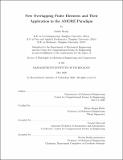New overlapping finite elements and their application in the AMORE paradigm
Author(s)
Huang, Junbin,Ph. D.Massachusetts Institute of Technology.
Download1191716244-MIT.pdf (10.76Mb)
Other Contributors
Massachusetts Institute of Technology. Department of Mechanical Engineering.
Advisor
Klaus-Jürgen Bathe.
Terms of use
Metadata
Show full item recordAbstract
The finite element method has become a fundamental analysis tool for modern sciences and engineering. Despite the great improvement in theory and application over the past decades, the need for regular conforming meshes in finite element analysis still requires much human effort in engineering practice. In this thesis we focus on designing novel finite element procedures to reduce the meshing effort expended on constructing a finite element model for solids and structures. The new meshing paradigm of "a̲utomatic m̲eshing with overlapping and regular elements", the AMORE paradigm, has recently been formulated. In this paradigm, the finite elements interior to the domain of interest are undistorted traditional elements and overlapping of elements is used for the discretization near the boundaries. The overlapping of elements gives much freedom to the meshing procedure and results in a much reduced meshing effort. Two types of overlapping are investigated. In the first case we consider the overlapping of individual polygonal elements and propose new quadrilateral overlapping finite elements. The new formulation combines advantageous aspects from both traditional finite elements and meshless methods. The new overlapping finite elements, being insensitive to mesh distortions and giving high-order accuracy, are used to mesh the boundary regions. Such use leads to an effective meshing procedure as desired. In the second case we study the overlapping of conforming finite element meshes. Each individual mesh is spanned over a regular subdomain and is allowed to overlap with other meshes in any geometric form. Local fields on individual meshes are then assembled using a partition of unity to give the global compatible field. This new scheme allows very convenient local meshing and enriching so that the meshes can be easily adapted to various geometric features and solution gradients with a reasonable computational expense. We formulate new schemes, analyze their convergence properties, and demonstrate their performance and their use in AMORE in the solution of various problems.
Description
Thesis: Ph. D. in Mechanical Engineering and Computation, Massachusetts Institute of Technology, Department of Mechanical Engineering, May, 2020 Cataloged from the official PDF of thesis. Includes bibliographical references (pages 129-134).
Date issued
2020Department
Massachusetts Institute of Technology. Department of Mechanical EngineeringPublisher
Massachusetts Institute of Technology
Keywords
Mechanical Engineering.